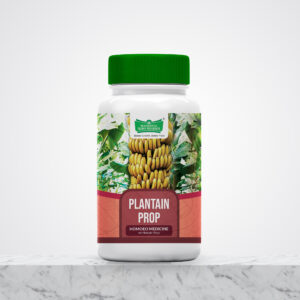It is a Homeopathic medicine made to help the farming of Plantain trees. Plantain plant are very delicate structure which is can be an easy target of pest and pathogens. Plantain Prop serves as a boost the immunity and its pest resistance.
The Plantain trees belongs to genus Musa. It is grown in tropical and subtropical climates. It is a big herb that comes out of an underground stem or rhizome. It is about 3-10 metres of height, characterized by a false trunk formed as a result of leaf sheaths of long rigidly arranged leaves. It has a couple of outwardly protruding large leaves.
Characterization of Plantain Prop
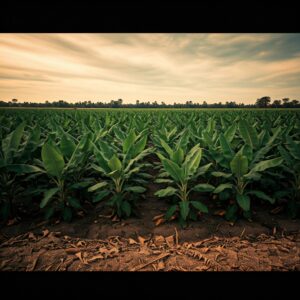 Pseudo trunk: It is the part of the Plantain tree which looks like a trunk but actually it’s a pack of sheath curled like a spiral form to gave a shape of stem. Eventhough it is fleshy which is mostly water but it cannot hold a bundle which weighs more than 50 kg.
Pseudo trunk: It is the part of the Plantain tree which looks like a trunk but actually it’s a pack of sheath curled like a spiral form to gave a shape of stem. Eventhough it is fleshy which is mostly water but it cannot hold a bundle which weighs more than 50 kg.
Leaves: The leaves are large, it has a length of three metres and width of half meter. The leaves have a mid rib which passes through middle and its joined to parallel veins which stretch through body of leaves in one dimension
Flowers: The growth of plantain flowers are in a cluster. Flowers were enclosed in bracts.
Fruits: The typical fruits which is also known as plantains, are elongated and varies in color when ripen.
Common Pest and diseases affecting Plantain trees
Like all other plants, banana trees are vulnerable to a variety of pests and illnesses that can negatively affect their growth, yield, and general health. Many problems, including stunted plant development, yellowed leaves, rotting roots, and early fruit maturity, might result from these pesky invaders.
 Among the most well-known pests that harm banana plants are aphids. These tiny, sap-eating insects are frequently observed in large numbers on the leaves and stems of banana trees. They produce poisons while they eat the plant’s sugary juices, which can cause the leaves to bend, deform, and eventually die. Because they can spread plant viruses, aphids pose a greater threat.
Among the most well-known pests that harm banana plants are aphids. These tiny, sap-eating insects are frequently observed in large numbers on the leaves and stems of banana trees. They produce poisons while they eat the plant’s sugary juices, which can cause the leaves to bend, deform, and eventually die. Because they can spread plant viruses, aphids pose a greater threat.
Another common pest is the mealybug. This insects hide in junctions of the leaf and on the pseudo trunk of the plantain tree, sucking on sap and weakening the plant as a result. They can also produce honeydew, a sticky material that attracts ants and sooty mold.
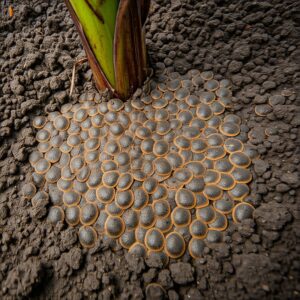 Nematodes are small roundworms that feed on the roots of plants and live in the soil. They can harm the roots as they eat them, which will make the plant stifle, become yellow, and eventually die. The plant’s capacity to absorb nutrients and water can also be diminished by nematodes.
Nematodes are small roundworms that feed on the roots of plants and live in the soil. They can harm the roots as they eat them, which will make the plant stifle, become yellow, and eventually die. The plant’s capacity to absorb nutrients and water can also be diminished by nematodes.
Another insect that can seriously harm banana trees is the Banana weevil. These beetle larvae severely injure fruits and pseudostems by boring into them. Fruit production on infected plants may decrease in quantity and quality, as well as occur in smaller fruits.
When it comes to diseases, Panama disease is a particularly devastating fungal infection. The fungus attacks the roots of the plant, causing them to rot. As the roots decay, the plant becomes unable to absorb water and nutrients, leading to wilting, yellowing, and eventually death.
Black sigatoka is another fungal disease that can affect banana trees. This disease is characterized by the appearance of dark spots on the leaves of banana plants. As the disease progresses, the spots can merge, causing the leaves to become severely damaged. This can reduce the plant’s photosynthetic capacity, leading to lower yields and reduced fruit quality.
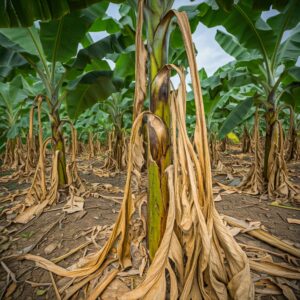 Bunchy top virus is a viral disease caused by aphids. The plant is stunted, the leaves are irregular and have a clustered or arched appearance. Infected plants produce fewer and fewer fruits, often resulting in reduced fruit quality. Knowing the pests and diseases that affect banana trees is essential to effective pest and disease management.
Bunchy top virus is a viral disease caused by aphids. The plant is stunted, the leaves are irregular and have a clustered or arched appearance. Infected plants produce fewer and fewer fruits, often resulting in reduced fruit quality. Knowing the pests and diseases that affect banana trees is essential to effective pest and disease management.
How Plantain Prop Benefits the Plantain or Banana tree
Plantain trees’ immunity can be improved by the fertigation of Plantain Prop, which activate specific enzymes crucial for plant defense. The application of these remedies stimulates receptors in the plant, resulting in increased production of enzymes such as chitinases and glucanases. These enzymes are vital for breaking down the cell walls of fungi and the exoskeletons of insects, effectively targeting and neutralizing these threats. As enzyme activity increases, the plant’s ability to combat pests and pathogens is enhanced. Furthermore, the activation of these enzymes triggers additional defensive responses. For example, when chitinases break down fungal cell wall chitin, it not only eliminates the immediate threat but also prompts the plant to produce additional protective compounds, such as phytoalexins.
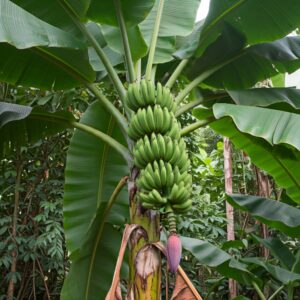 The part of the plantain trees roots responsible for absorption of essential nutrients is called root hairs. There is a considerable amount of nanoparticles are available in the medicine. Which can target all the parts of the tree. It mainly targets the root hairs, Activates the production of growth hormone for the better growth of the root hair. It enhances the nutrient intake of the plant.
The part of the plantain trees roots responsible for absorption of essential nutrients is called root hairs. There is a considerable amount of nanoparticles are available in the medicine. Which can target all the parts of the tree. It mainly targets the root hairs, Activates the production of growth hormone for the better growth of the root hair. It enhances the nutrient intake of the plant.
The rate of photosynthesis increases due to higher chlorophyll content, which can be enhanced by plantain extracts. These extracts may alter the plant’s physiology by targeting DNA receptors, stimulating the production of chlorophyll.
Plantain Prop have the potential to support helpful soil microorganisms, which are essential for nutrient recycling and enhancing the resilience of plants. Ultimately, this synergistic approach can result in stronger and healthier plants that are more capable of withstanding environmental pressures.
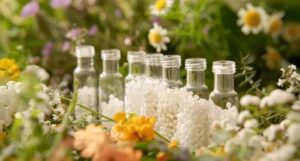 Moreover, Plantain Prop can be used as a fertilizer. Macro nutrients needed for the plants are for plantain trees are nitrogen, phosphorus, potassium, calcium, magnesium, and sulfur. Micronutrients like iron, manganese, zinc, and boron are also important for optimal growth and health. Traditionally, those can be given to plantain trees in the form of Chemical fertilizers to its soil for absorption. Fertilizers are not its essential nutrients. Essential nutrients are in the form of compounds in nature. So, there is an always an issue of absorption of right nutrients. For Plantain Prop, As I’ve mentioned earlier, it enhances the root hairs’ growth, when used as a fertilizer it can help the plant to absorb the exact essential nutrients which it needs from the soil itself
Moreover, Plantain Prop can be used as a fertilizer. Macro nutrients needed for the plants are for plantain trees are nitrogen, phosphorus, potassium, calcium, magnesium, and sulfur. Micronutrients like iron, manganese, zinc, and boron are also important for optimal growth and health. Traditionally, those can be given to plantain trees in the form of Chemical fertilizers to its soil for absorption. Fertilizers are not its essential nutrients. Essential nutrients are in the form of compounds in nature. So, there is an always an issue of absorption of right nutrients. For Plantain Prop, As I’ve mentioned earlier, it enhances the root hairs’ growth, when used as a fertilizer it can help the plant to absorb the exact essential nutrients which it needs from the soil itself
USAGE
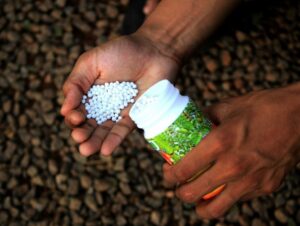 To keep your plantains healthy, start by mixing 50 globules in 3 liters of water. Pour that around the base of the plant to really soak the roots. It’s good to do this every couple of months to support their growth.
To keep your plantains healthy, start by mixing 50 globules in 3 liters of water. Pour that around the base of the plant to really soak the roots. It’s good to do this every couple of months to support their growth.
For planting a banana tree, you’ll want to use a slightly different method. Dissolve 50 tablets in 1 liter of water and then soak the banana plantlet in that solution for about five minutes. After soaking, let it dry a bit before you plant it.
Also, to prevent issues like leaf wilting or diseases, consider spraying a mixture of 50 tablets in 3 liters of water every two months. This routine will help keep your banana tree healthy and vibrant.
